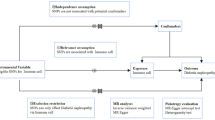Abstract
The IL4 C(−590)T, IL4RA Ile50Val, and TNF G(−308)A polymorphisms were tested for association with quantitative traits important for chronic virus hepatitis, including the levels of IL4, IL10, IL12, TNF-α, fibronectin, collagenase, the proteinase inhibitor, macroglobulin, and free and protein-bound (PBO) oxyproline. Allele A of the TNF G(−308)A polymorphism was associated with a lower TNF-α production by mononuclear cells, a higher production of IL4 and IL12, and a lower PBO level. The genotype CT of the IL4 C(−590)T polymorphism was associated with a high PBO level.
Similar content being viewed by others
References
Valenkevich L.N., Yakhontova O.I. 2000. Noncirrhotic liver fibrosis. Ross. Gastroenterol. Zh. 4, 21–23.
Zorin N.A., Zorina R.M., Gorin V.S. 1993. The macroglobulin family. Klin. Lab. Diagn. 1, 52–56.
Harada N., Okajima K., Liu W., et. al. 2000. Activated neutrophils impair gastric cytopritection role of neutrophil elastase. Dig. Dis. Sci. 45, 1210–1216.
Robert L. 1999. Interaction between cells and elastin: The elastin receptor. Connect. Tissue Res. 40, 75–82.
Tsaregorodtseva T.M., Serova T.I. 2003. Tsitokiny v gastroenterologii (Cytokines in Gastroenterology). Moscow: Anakharsis.
Knapp S., Yee L.J., Frodsham A.J., et al. 2003. Polymorphisms in interferon-induced genes and the outcome of hepatitis C virus infection: Roles of MxA, OAS-1, and PKR. Genes Immun. 4, 411–419.
Toniutto P., Fabris C., Fumo E., et al. 2004. Carriage of the apolipoprotein E-epsilon4 allele and histological outcome of recurrent hepatitis C after antiviral treatment. Am. J. Clin. Pathol. 122, 428–433.
Bahr M.J., Menuawy M., Boeker K.H., et al. 2003. Cytokine gene polymorphisms and the susceptibility to liver cirrhosis in patients with chronic hepatitis C. Liver Int. 23, 420–425.
Powell E.E., Edwards-Smith C.J., Hay J.L., et al. 2000. Host genetic factors influence disease progression in chronic hepatitis C. Hepatology. 31, 828–833.
Rurko A.A., Ondar E.A., Freidin M.B., Pusyrev V.P. 2004. Genetics of susceptibility to tuberculosis in Tuvans. Vestn. Etnich. Med. 1, 17–21.
Freidin M.B., Goncharova I.A., Rudko A.A. 2006. Genomic bases of susceptibility to infectious diseases. Mol. Med. 3, 39–46.
Kuznetsova T.P., Proshina L.Ya., Privalenko M.N. 1982. Modification of serum oxyproline content. Lab. Delo. 8, 8–10.
Nartikova V.F., Paskhina T.S. 1979. A unified method for determining α1-antitrypsin and α2-macroglobulin in human blood serum (plasma). Vopr. Med. Khim. 25, 494–499.
Sharaev P.N. 1981. A method for determining free and bound oxyproline in blood serum. Lab. Delo. 5, 283–285.
Sharaev P.N., Pishkov V.N., Zavorygina N.G. 1987. Determination of collagenolytic activity of blood plasma. Lab. Delo. 1, 60–62.
Lakin G.F. 1990. Biometriya (Biometrics). Moscow: Nauka.
Lahiri D.K., Bye S., Nunberg J.I., et al. 1992. A non-organic and non-enzymatic extraction method gives higher yields of genomic DNA from whole-blood samples than do nine other methods used. J. Biochem. Biophys. Meth. 25, 193–205.
Mitsuyasu H., Izuhara K., Mao X.-Q., et al. 1998. Ile50Val variants or IL4Rα upregulates IgE synthesis and associates with atopic asthma. Nature Genet. 19, 119–120.
Noguchi E., Shibasaki M., Arinami T., et al. 1999. Lack of association of atopy/asthma and the interleukin-4 receptor α gene in Japanese. Clin. Exp. Allergy. 29, 228–233.
Wilson A.G., Symons J.A., McDowell T.L., et al. 1997. Effects of a polymorphism in the human tumor necrosis factor alpha promoter on transcriptional activation. Proc. Natl. Acad. Sci. USA. 94, 3195–3199.
Seitova G.N., Bukreeva E.B., Puzyrev V.P. 2006. Association of the TNF gene promoter polymorphism with the level of tumor necrosis factor-alpha in serum of COPD patients. 16 th ERS Annual Congr. 2006. Munich, Germany. Eur. Respir. J. 522–523.
Goncharova I.A., Beloborodova E.V., Freidin M.B., et al. 2008. Genetic factors predisposing to a chronic course of virus hepatitis and liver fibrosis. Mol. Biol. 42, 238–241.
Author information
Authors and Affiliations
Corresponding author
Additional information
Original Russian Text © I.A. Goncharova, E.V. Beloborodova, M.B. Freidin, E.I. Beloborodova, G.E. Chernogoruk, V.P. Puzyrev, 2008, published in Molekulyarnaya Biologiya, 2008, Vol. 42, No. 2, pp. 242–246.
Rights and permissions
About this article
Cite this article
Goncharova, I.A., Beloborodova, E.V., Freidin, M.B. et al. Association of immune system gene polymorphisms with quantitative traits pathogenetically important for chronic virus hepatitis. Mol Biol 42, 213–216 (2008). https://doi.org/10.1134/S0026893308020064
Received:
Accepted:
Published:
Issue Date:
DOI: https://doi.org/10.1134/S0026893308020064




